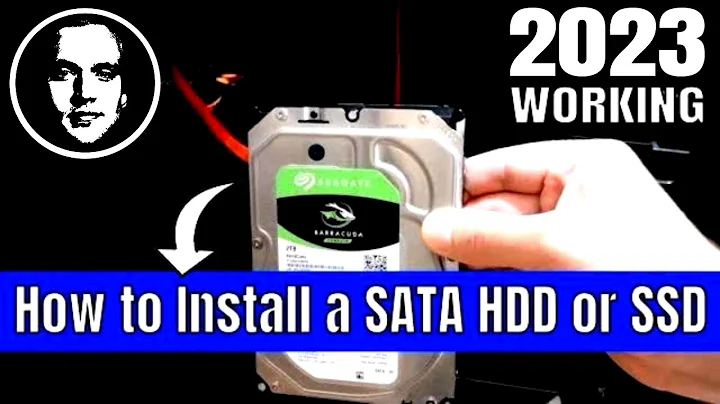Connecting SATA drives after the computer is booted up
Although your question doesn't specifically ask anything that will get a single best community answer, here is the "why" and the easiest workaround:
Why? Because your computer is probably configured to boot from any of the hard disks through the BIOS and you haven't stated any order. If one of the drives has priority and it has a valid boot sector that can boot to an OS, it will.
Workaround: Go into your computer BIOS and ensure only your "host" OS hard drive is in the boot order. All other hard disks should be removed from the boot order. Your "secondary" hard disks will then become additional disks when your OS boots up - allowing you to do what you need to do.
Related videos on Youtube
WestWindsDemon
Updated on September 18, 2022Comments
-
WestWindsDemon over 1 year
I'm trying to clone an HDD, that's the end goal here. I tried to boot up my PC with all the HDDs involved connected (host drive, drive A and drive B to be formatted and copied over; all drives have an OS installed), and my pic boots up the wrong drive. I've tried to manually boot up the host drive but it will just not boot while the other HDDs are connected. Now I'm trying to connect and access HDD A & B after I have booted the host drive and after some research (Google searches) I don't have the slightest idea on how to access them. Please help.
-
Paul almost 6 yearsAt a minimum your SATA controller needs to be in AHCI mode - if it is, and it doesn't work by just trying it, then it might be that your controller doesn't support hotplug SATA.
-
 Akina almost 6 yearsConnect host drive to one SATA channel, and drives A and B to another channel. Disconnect drive's A/B power cords. Boot up. Open Device manager and disable SATA channel which A/B are connected to. Attach power cords to A/B. Enable SATA channel which A/B are connected to. If OS asks for reboot - cancel it. Make sure A/B are detected correctly in Device manager and Drive manager. Make sure their volumes and files/folders are accessible (if they have no letters - add it). Perform actions you need. Shutdown and disconnect A/B.
Akina almost 6 yearsConnect host drive to one SATA channel, and drives A and B to another channel. Disconnect drive's A/B power cords. Boot up. Open Device manager and disable SATA channel which A/B are connected to. Attach power cords to A/B. Enable SATA channel which A/B are connected to. If OS asks for reboot - cancel it. Make sure A/B are detected correctly in Device manager and Drive manager. Make sure their volumes and files/folders are accessible (if they have no letters - add it). Perform actions you need. Shutdown and disconnect A/B. -
 Kinnectus almost 6 years@Akina - Quite possibly the worst advice to tell a user to connect and disconnect SATA devices with the power/computer on/booted if the ports aren't hot-swap... Initial due diligence and common sense steps should be used first... There should be absolutely no need to remove power/data cables if the BIOS/UEFI has been configured not to use the specific drives. This is what this order list is for.
Kinnectus almost 6 years@Akina - Quite possibly the worst advice to tell a user to connect and disconnect SATA devices with the power/computer on/booted if the ports aren't hot-swap... Initial due diligence and common sense steps should be used first... There should be absolutely no need to remove power/data cables if the BIOS/UEFI has been configured not to use the specific drives. This is what this order list is for. -
WestWindsDemon almost 6 years@Paul - I'm not sure if my controller (I'm going to assume it's part of the motherboard) supports hotplug, how can I find out and it's that a software issue that I could potentially fix with a BIOS flash or a hardware one?
-
-
WestWindsDemon almost 6 yearsI have tried to put them in a boot order, but the system does not seem to care and picks whichever HDD it wants from the other two. I've got to admit, I'm not entirely sure how to remove HDDs from the boot order; haven't seen that option. I will try this when I get home today. I'll let you know how it goes, thanks!
-
 Kinnectus almost 6 yearsYou should be able to take devices out of the boot order... it'll either be shown as removing devices from a list, or by showing an exclamation mark signifying it's not included in the BIOS process.
Kinnectus almost 6 yearsYou should be able to take devices out of the boot order... it'll either be shown as removing devices from a list, or by showing an exclamation mark signifying it's not included in the BIOS process. -
 Akina almost 6 yearsThose disks are to be set as "No device" in BIOS. After OS boots up it will detect them using its own disk drivers.
Akina almost 6 yearsThose disks are to be set as "No device" in BIOS. After OS boots up it will detect them using its own disk drivers. -
WestWindsDemon almost 6 yearsWould it help to say that all the HDDs have an OS installed in them? Don't know if I mentioned that.
-
 Kinnectus almost 6 years@WestWindsDemon, you did mention that, and that is why I've answered with what I have. the fact you have multiple disks with the potential to be booted from, it's important your BIOS/UEFI knows which one to boot from first - hence the BIOS boot order menu in pretty much all computers. Can you confirm if your BIOS boot menu has been configured to only allow your main OS (the "host", in your question) to be bootable? A screenshot of your BIOS boot order identifying your prefered HDD would be useful to add to your question if the menu is being ignored (unlikely).
Kinnectus almost 6 years@WestWindsDemon, you did mention that, and that is why I've answered with what I have. the fact you have multiple disks with the potential to be booted from, it's important your BIOS/UEFI knows which one to boot from first - hence the BIOS boot order menu in pretty much all computers. Can you confirm if your BIOS boot menu has been configured to only allow your main OS (the "host", in your question) to be bootable? A screenshot of your BIOS boot order identifying your prefered HDD would be useful to add to your question if the menu is being ignored (unlikely). -
WestWindsDemon almost 6 years
-
 Kinnectus almost 6 yearsIs the HGST drive in your picture your "host" OS? the one with the actual OS you wawnt to boot up?
Kinnectus almost 6 yearsIs the HGST drive in your picture your "host" OS? the one with the actual OS you wawnt to boot up? -
WestWindsDemon almost 6 yearsIt is the host drive.
-
 Wilson F about 4 yearsHi. Where did the rest of this discussion go? I'm having this exact problem (with what looks like the same or similar BIOS, based on that photograph): my computer won't boot from the correct HD. When the BIOS is set not to use 'legacy', I can't see the individual drives in the boot order (though I can see them in the device list). The boot order just has
Wilson F about 4 yearsHi. Where did the rest of this discussion go? I'm having this exact problem (with what looks like the same or similar BIOS, based on that photograph): my computer won't boot from the correct HD. When the BIOS is set not to use 'legacy', I can't see the individual drives in the boot order (though I can see them in the device list). The boot order just hasubuntu,Linux Firmware UpdaterandWindows Boot Manager. When I enable legacy booting, I see both drives, but booting doesn't work.





